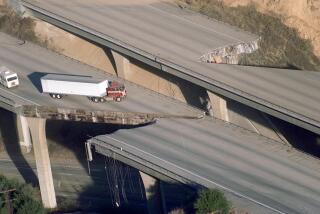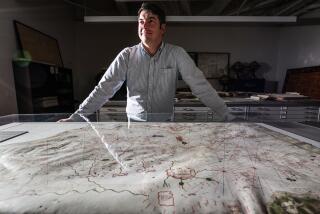Fans Hail Map-Making Revolution
- Share via
The 50 people who gathered Saturday at Cal State Northridge had one thing in common: All are mad about maps.
The campus was the site of the 40th general meeting of the California Map Society, an organization of 165 members devoted to the preservation and celebration of maps. This year, there is much to celebrate. As members explained, cartography, or the making of maps, has undergone a revolution in the last decade. Thanks to computers and related technology, maps are easy and inexpensive to make for the first time in their history--one that predates the invention of written languages.
“It’s a revolution even greater than any of the previous revolutions in the history of cartography,” said Norman Thrower, a UCLA cartographer and historian who was the society’s first president.
Those earlier revolutions, he said, were the invention of printing, the use of statistical information and the invention of the airplane, which first allowed map makers to have the bird’s-eye view they had previously created out of surveyors’ data and their own imaginations.
The speed with which the new machines can generate maps is a marvel to anyone who went to graduate school 20 years ago and learned map making when a steady hand was almost as important a skill for a map maker as good information and a knack for design.
“I can turn out a finished map in less than 1/1000th of the time I did when I came here 20 years ago,” former geography department Chairman William Bowen said during a talk on digital mapping of the socioeconomic landscape.
Thrower recalled how he had recruited a raft of graduate students to do the labor-intensive work of mapping the population of California, using the data from the 1960 U.S. census. “It took five years before it could be published,” he said of that pre-computer map. “Now we could do that almost instantaneously.”
Many society members collect maps, in part, because they are often so beautiful. Society President William Warren, a retired engineer who lives in Pasadena, is one such collector. He recalls with relish how he acquired a 1656 map by Dutch master Henderick Doncker. Found on a wall in Amsterdam at the end of World War II, it shows California as an island, a vivid artifact from the period when the Spanish jealously guarded geographic information about California and the rest of New Spain from the outside world.
“Too expensive,” Warren told the dealer who asked $600 for the map, only to have his wife later give it to him as a gift.
However lovely a map may be, society members understand that maps are, above all, a means of communicating information. People’s lives have traditionally depended on the quality of their maps. “In a sense,” Bowen said, “maps allow you intellectually to stand back from something and see the whole. With the new technology, we can literally see things that can’t be seen.”
For their makers, maps are often a tool of discovery. As a cartographer, Thrower said, “you never really know what you want to show. You make something and then you find out something.”
He gave as an example his 1960 map of California’s population. That revealed that 75% of the population lived on 2% of the land.
During the meeting, members toured Cal State Northridge’s recently expanded map library, the largest in the California State University system. Housing about 300,000 maps, the map library occupied cramped quarters in Sierra Hall until January 17, 1994. That was the date of the Northridge quake, when map curator Michael Swift joked, “God spoke, and he let us know that he wanted more room for the map library.”
Although map drawers tumbled, Swift said the library was fortunate that there was little or no damage to the jewel of the Cal State Northridge map collection, its extensive holdings published by the Sanborn Map Co., beginning in the 1880s.
Originally designed for use by fire insurance underwriters in determining risk, these maps, updated annually, provide detailed information about buildings in the commercial centers of most U.S. towns.
Today, the collection is frequently used by companies preparing the legal documents required of owners to show that any environmental hazards have been addressed before properties can be sold.
Although the maps were commercial in intent, they also reveal a great deal about changing social geography. Swift showed the group an 1888 Sanborn map of downtown Los Angeles that boasts a sprawling vineyard and numerous houses of prostitution, euphemistically labeled “Female Boarding.” Some of the place names and descriptions on the maps include ethnic slurs that make a contemporary viewer wince.
More to Read
Sign up for Essential California
The most important California stories and recommendations in your inbox every morning.
You may occasionally receive promotional content from the Los Angeles Times.










